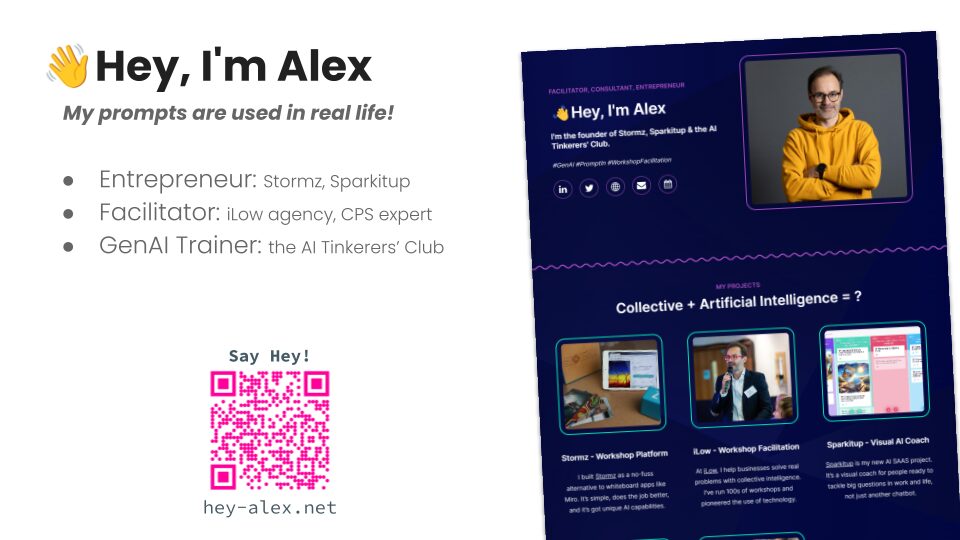
How can incorporating AI into our workflows truly make a difference for facilitators and trainers? In this article, we will explore seven generative AI use cases for facilitated workshops and training programs.
We will look at real, practical use cases for preparing sessions, improving outcomes while running workshops, and documenting the outcomes of a discussion.
Using AI is not just about saving time: it can actually enhance how you run your training practice. Let’s see how!
In this article, you will find practical, real-world use cases. My purpose is not to exhaust the possibilities of AI for facilitators and trainers, but rather to kick-start a learning process, expose you to new ideas and inspire you to try out new solutions. We will be not just be looking at prompts (although there are a couple of those as well), but going beyond that to describe actual examples of how facilitators and trainers can put AI to work, step by step.
The examples you will find below are grounded in real-world experience and practice, both mine and that of members of the AI Tinkerer’s Club. In other words, there are not shiny, imaginary demos. They are practical tools and techniques we are piloting in the real world, to solve our real problems.
Do note that I will not be discussing the technology or the models in and of themselves, but looking specifically at uses of AI for training. How can AI make your job easier and, ultimately, your workshops and live training sessions better?
Here is what we’ll cover in the next pages:
Think about everything you do as a facilitator or a trainer. You create and market training courses, you prepare workshops, you facilitate experiences, you document outcomes, and so on. For each of those steps, there are hundreds of possible use-cases AI can help you with.
What is a use case?
A use case is a scenario, a situation in which you can use a certain tool to achieve a desired result. It is not limited to a single step, such as giving instructions to an AI to have it deliver an output, but might include various different steps, combining human and large language model work.
Consider your own workflow: which tasks are repetitive, which are a bit of a pain, and where do you have a sense you might achieve more or better? Each of those individual actions can be turned into small, practical ways to use AI; put together they can add up to make a huge difference in your work
Once you see some examples, it should become clear that you can, and should, be creating your own use cases about how to work with AI in the best possible way for you. To develop such a use case, you should think about everything you do to prepare, run and report on a session, and divide it into a number of smaller tasks.
Here are some examples. Choosing a question to use as icebreaker. Coming up with categories to cluster ideas. Creating course content and materials. Providing clear instructions for a breakout room conversation. It is not feasible to tell a generative AI tool to create a whole workshop for you (and it certainly can not run it.. yet!), but you can, and should, train it to perform some of those microtasks.
Facilitators, trainers, coaches and experts can benefit vastly from including artificial intelligence models in their work, but in order to understand how, we need to experiment, play, practice and, in a word, tinker. This is why I founded the AI Tinkerers’ Club: a community of over 600 practitioners sharing the good, the bad and the ugly of this new world. Follow this link to learn more and join us!
3 things to keep in mind when using GenAI for training
Before we look at 7 use cases you can take inspiration from, it is important to introduce a few key principles that should run through everything you do when working alongside artificial intelligence models: the sandwich, the springboard, and the principle of self-disclosure.
Sandwich: start with human, end with human.
The sandwich principle is the most important concept to keep in mind whenever you use AI, no matter the task.
The principle consists of three key layers:
- Start with the best possible human input. This is the first layer of the sandwich. Provide clear, detailed instructions or data to set AI up for success.
- Let AI do the job with the best possible prompt. This is the second layer. Use a well-crafted prompt to guide the AI in performing the task effectively.
- End with human refinement. This is the final layer of the sandwich. Always review and refine the AI’s output. Don’t just copy and paste the results. Apply quality control, adjust for your tone of voice, add humor, personality, or any specific touch. Whatever makes it truly yours.
For example, I often use AI to simplify and clarify my language when delivering instructions. I start with an instruction draft that might be messy in form but contains all the necessary details. Then, I craft a prompt and let the AI do its job. Finally, I refine the output by adding personal touches and ensuring the final result aligns with my style and needs.
Whenever you open an AI tool, always remember the sandwich principle: human input > AI processing > human refinement.

Springboard: use output from AI tools to generate something new.
Using AI is not an excuse for sloppy or lazy work. In fact, co-working alongside GenAI can help you be more original, and challenge yourself to new heights. This can only work if you remember that you should use AI as a springboard for better ideas and a better performance, not as a substitute for putting in the work.
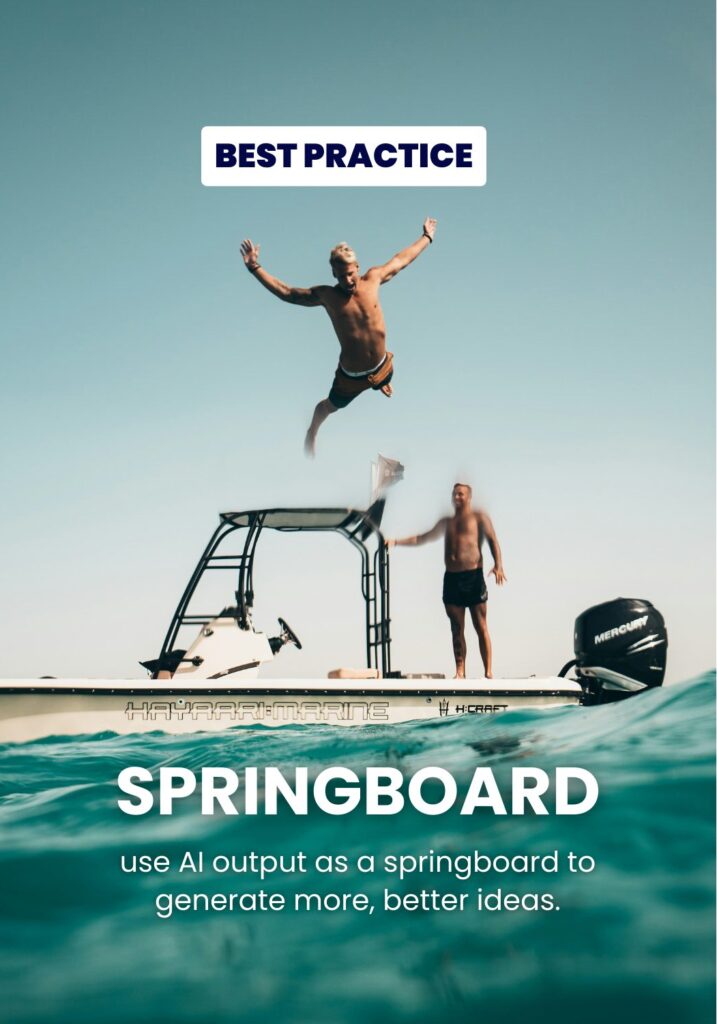
Self-Disclosure: bots should never pretend to be human.
As you’ve figured out by now, this approach to working with AI implies a lot of back and forth between humans and machines. We start with human input, feed it back into the machine, refine it as humans, and so on.
For this to work well, AI output must always clearly be identified as such. In Use Case No. 5 below, which is all about brainstorming with AI as your sparring partner, you will see some tips on how to clearly differentiate AI-generated ideas from human-generated ones.
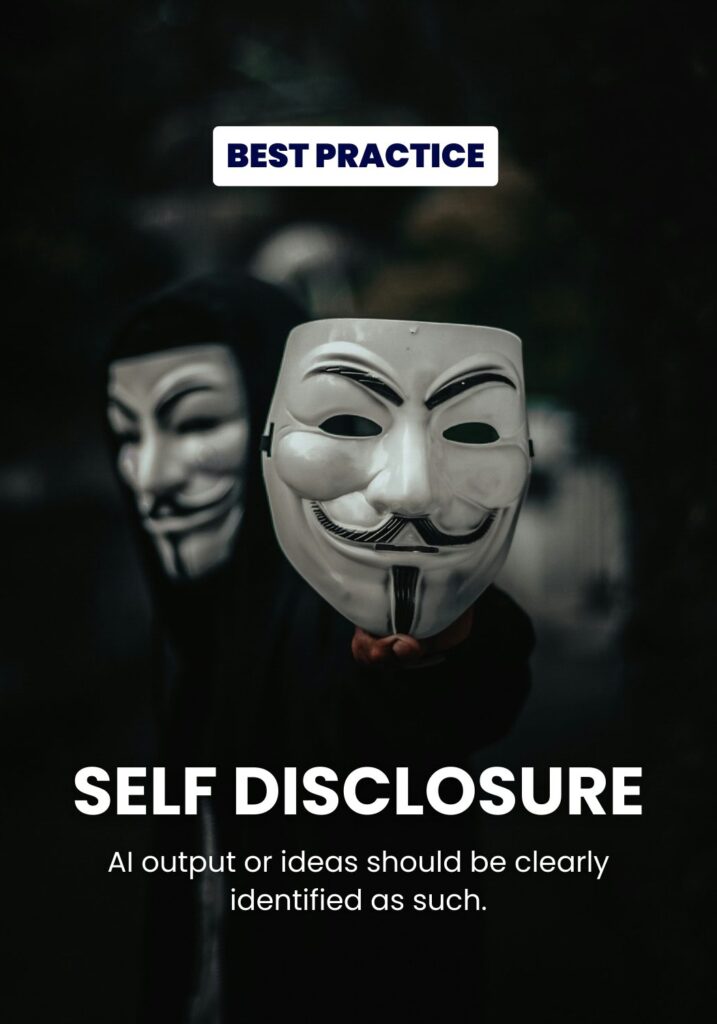
Facilitators may just be learning to appreciate AI, but there is another tool they have always loved: card decks! Cards are a wonderful way to arrange and re-arrange ideas and show thinking in action. The images above come from a card deck I’ve created as a resource to lead learning experiences in which we explore the many aspects and possible uses of AI in organizations and companies. Intrigued? You can print or order a deck from this link.
Using GenAI to prepare and design training courses and workshops
Now that we are clear about what to keep in mind when using AI in training courses and as a partner in your facilitation work, let’s start digging into some practical use cases and examples.
To begin with, we’ll be taking a look at what GenAI can do to help in developing and designing workshops. This is the phase where it feels safest to play around with new tools, since there is no fear that they will fail you in front of participants, nor much client supervision to worry about. In fact, design and preparation work can be a bit lonely, repetitive and tedious in parts. In other words, it’s the perfect place to start checking out what AI can do to improve your life and work!
We will explore four key use cases: how to assess your design, turn a rough draft into a smooth session, create evaluation criteria, and prepare a scope document for your clients. Remember, the idea here is to get inspiration and a sense of the potential of generative AI tools for your practice.
You’ll notice that I do not mention or endorse any specific, individual tool here. These use cases are tool agnostic, by which I mean that they can work with different tools, from ChatGPT to Gemini and beyond.
For practical purposes, I am often using a specific tool in these examples, but that does not mean it is the only possible way to do it. The landscape of artificial intelligence applications is evolving and changing all the time: to stay abreast and play with all the latest solutions, consider joining the AI Tinkerer’s Club!
A very important point to make is that these use cases are not merely about making your work faster, but also about making your work deeper and better. I believe this is something very important to keep in mind: AI in training is not only about speeding processes up, but also about enabling trainers to do things we could not do on our own.
This first case is a great example: did you know that you can leverage AI capabilities to help you find your own blind spots?
Use Case No.1 – Assessing your preparation work with the Blind Spot Detector
Our first use case starts from the very early stages of preparation. This is when you have a budding idea for a workshop; perhaps you have just been contacted by a client, but everything is still up in the air and muddled.
So many facilitators and trainers are solopreneurs: a workshop’s initial preparation phase can feel lonely, and might benefit from having an always-available sparring partner to ideate with. How can AI help you put thoughts in order and inject new knowledge into your work?
This use case, the Blind Spot Detector, comes from a member of the AI Tinkerers’ Club who shared a clever workflow that combines several AI-powered steps.
Step 1 – Explore
Start by recording a voice note, just thinking out loud about the topic you want to explore. If you prefer to ramble in writing, you can also do that, but it’s good to be aware that AI models now have the power to analyze voice notes, which can certainly be faster.
Step 2 – Summarize
Ask AI to summarize the transcript into a concise set of clean notes. This is a classic use of AI skills—simple yet effective, using voice-to-text transcription—and something we absolutely couldn’t have done a few years ago.
Step 3 – Assess
Ask AI to detect blind spots in your reasoning. What you are doing here is using AI to help you assess your own work.
Assessment use cases are some of my favorite ways to leverage the power of artificial intelligence. This isn’t about using AI to do work in your stead; it’s about using AI to push you to raise the bar. For example, AI can highlight the pros and cons of your ideas, point out potential gaps or weaknesses, and draw your attention to logical fallacies and biases.
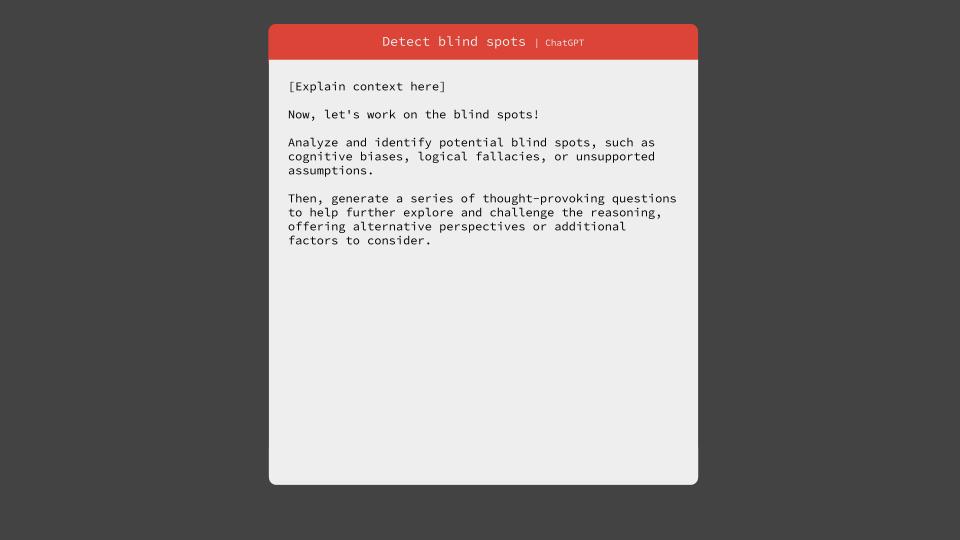
Use Case No 2 – Conjuring up detailed training programs using SessionLab AI
Our second use case is about integrating AI in the workflow of preparing training programs: specifically, how to go from a high-level workshop design to a detailed, polished plan.
When I prepare a workshop, I start by creating a general overview on a whiteboard. In my case, I use an online whiteboard, but it’s the same process if you prefer to use pen and paper and sticky notes. Once I’ve drafted my design, I move it to SessionLab’s planner where I create blocks for each section and fine-tune the details.
Moving from the macro design to the detailed step-by-step plan used to be very time-consuming. No shortcuts were available: I had to write out each step clearly because this document would be shared with my client.
With the help of AI, however, this process is much faster and easier. Here’s what I do: I take a screenshot of my whiteboard, then I prompt ChatGPT to transcribe it. As individual learners, you may not have already realized that AI has the ability to turn a simple picture or screenshot into text. A lot of interesting use cases are unlocked once you figure out the potential of voice-to-text and image-to-text translation.
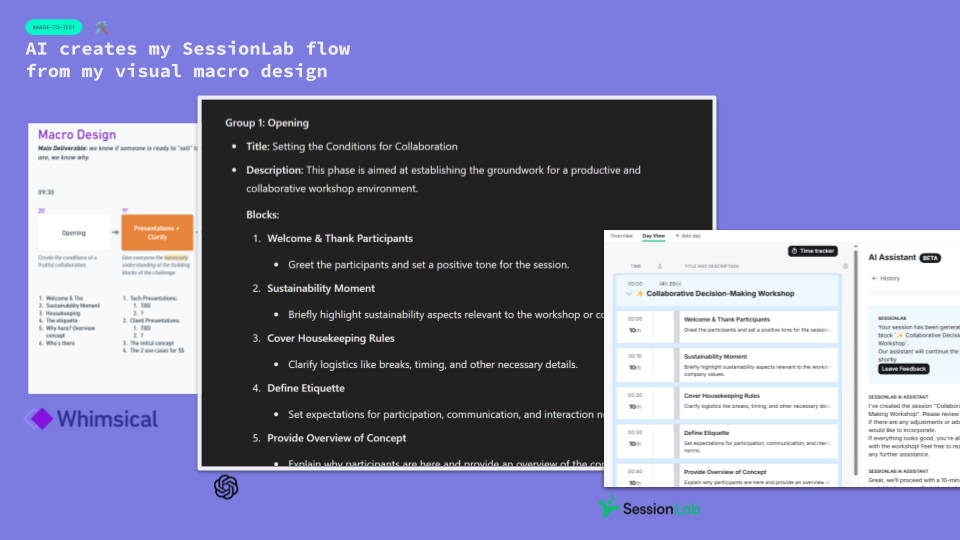
Furthermore, this isn’t just a basic transcription: I have prepared a standard set of instructions through which the AI refines everything. It organizes titles, adds descriptions and key points, identifies main sections like “Opening,” and breaks down substeps with consistent formatting. Group titles are written as nouns, step titles use action verbs, and descriptions are clear, one-sentence summaries. The result is a beautifully crafted document in just seconds. It even works with different languages (I work in both French and English, so this is a very useful feature for me).
Once I have my session outline, I copy all the text ChatGPT has generated and paste it directly into SessionLab’s AI assistant. In seconds, it imports all the titles and descriptions, turning them into a polished session plan. From there, I just need to fine-tune the timing. So, within 15 minutes, I’m ready to refine and finalize my workshop design. All from just a screenshot of a whiteboard!
These workflows leverage multimodal inputs and outputs.
- When using a screenshot of my macro design, I input an image, and the output is text.
- In the earlier example with the voice recorder, the input was audio, and the output was also text.
Once you start to track all the possibilities with multimodal inputs, outputs, and external integrations, you’ll discover countless new ways to use generative AI in your work.
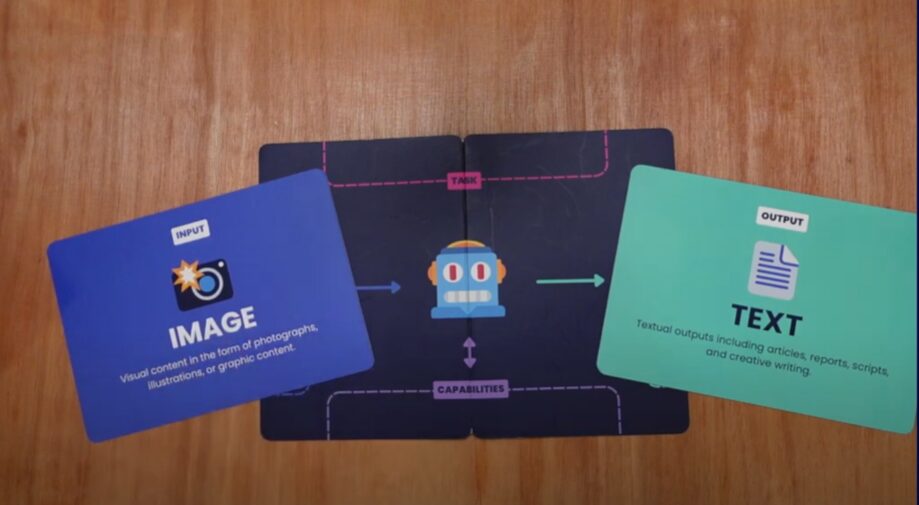
Use Case No. 3 – Coworking with AI to create evaluation criteria
This is an example of co-working with AI; it might be very specific and tailored to the kinds of workshop I run, but it will give you a sense of how you can use these tools to accelerate the preparation of training materials and other prep work you might need to do for a complex training course.
As part of my corporate training work, I often lead decision-making, strategic decision and/or risk analysis workshops. The core of these activities often lies in organizing different ideas or proposals in a matrix, as an aid to decision-making. In particular, I often use an evaluation tool called multiple criteria evaluation.
When preparing for a multiple criteria evaluation session, there are several steps.
- First, the facilitator needs to identify the criteria. This isn’t always straightforward, due to the many possibilities.
- Once criteria are selected, each must be defined, with a clear title and description to ensure participants understand them.
- Next, facilitators need to create an evaluation scale. For each point on the scale, there should be a label. If, for example, we have three criteria with a 10-point scale, that means writing out 30 labels, which is very time-consuming.
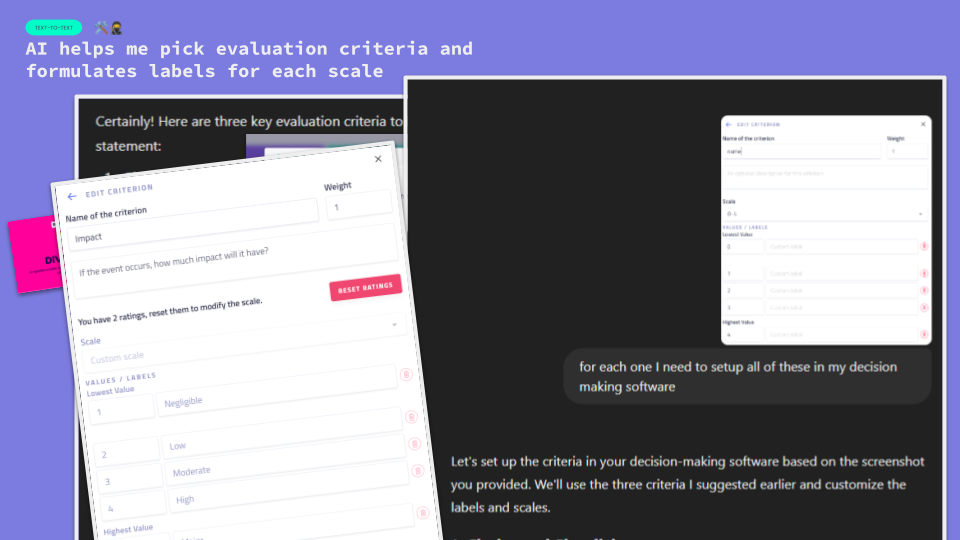
Using an AI tool saves time and produces better-defined criteria than I could on my own. I co-work with AI by explaining the workshop’s context and decision goals. The AI generates 20-30 potential criteria, and together, we refine the list to two, three, or four. AI also provides descriptions for the selected criteria. Additionally, I ask it to create titles, short descriptions, and labels for each scale point. This saves so much time while maintaining quality. Although the output is 80-90% accurate, I still apply the final “sandwich layer” of refinement.
Remember the sandwich principle: automatically generated lists are just part of the workflow. Start with human input, end with human revision.
Use Case No. 4 – Transform a meeting into a scope document
Going back and forth between our personal workflows and our clients’ is a typical pain point for freelance facilitators. Different people have different ways of working and if we don’t know one another yet very well, explaining each detail or bit of jargon can be quite tedious.
In this use case, I use AI technologies to make this part of my work easier, by transforming the recording of a scope meeting into a formal document.
The scope meeting is probably the most important preparation meeting with clients. During a scope meeting, it is important to discuss the objective of the future session, what benefits participants will have, and any constraints (such as, for example, duration of the course).
There are a few key questions and bits of information the facilitator will always be looking for, and they are likely to often be the same. Who will participants be? What are the knowledge gaps the client wishes to bridge with this learning opportunity? What are the desired outcomes? The more standardized your process and questions are, the greater the opportunity to leverage AI for training. Here is how it works:
Step 1 – Record and transcribe your scope meeting.
First, the meeting voice recording is transformed into a raw text transcript.
Step 2 – Run the transcription through your own, customized, prompt.
By uploading your old scope documents and adding a list of present requirements, you can train the AI tool to look for the information you need. I have prepared a detailed specification questions that lists questions I should ask and things to be on the lookout for.
I have two outputs in the end:
- The first one is a scope meeting document that is 80 to 90% good. This is a huge time saver. All I need to do is re-read and edit it to have something ready to present to my client, very quickly after our meeting.
- The second, as we saw in Use Case No. 1, is an assessment document. It detects if I forgot to ask some questions. It gives me recommendations on what to ask to gain a better understanding of the context. If I have forgotten to ask about something during the meeting, my AI assistant is going to detect it, and formulate the questions for me. All I need to do is then copy and paste these questions, refine them, and send an email to the client for a follow-up.
In this use case, I was using an advanced capability, called a data retriever, which means uploading documents to your AI system and feeding it external data.
The key learning here is that if you do something repeatedly—and I do this scope meeting every time I have a new workshop—it makes sense to invest some time in building such a complex workflow, because you’re going to have a return on investment. I can now send clients a follow-up email with a scope document and some follow-up questions the very next day from our meetings, freeing my time for something else and improving results.
AI for training and facilitating a workshop
If you’ve gotten this far, hopefully I have convinced you of the importance of learning how to leverage AI’s natural language processing abilities to speed up, and improve, the preparation phase of your work.
Next, we are going to look at two cases of how to use AI during a learning experience or facilitated session. This is something most trainers and facilitators are more reluctant to do, as it might lead to unforeseen outcomes in front of participants.
From my point of view, any unexpected results should be leveraged as starting points for great conversations. That said, if you’d like to practice and try things out, this could be a good reason to join us at the AI Tinkerers’ Club!
Use Case No. 5 – Using AI for brainstorming
Another way we could refer to AI is as a “probability machine”. When using AI for brainstorming, it won’t really produce “ideas” as such, but put together strings of sentences that are more or less likely to occur to us humans.
It’s a bit like that creativity practice of putting together unlikely elements to create a new product, story or sentence. Precisely because of how generative AI works, it’s an amazing tool for brainstorming. So, let’s see what facilitators and trainers need to know to use generative AI as an aide to brainstorming.
Whenever you are working with a group of people in the divergent phase of a workshop, trying to come up with as many ideas as possible, no matter how strange, AI tools can help you challenge and stretch participants’ thinking.
Essentially, all you need to do is ask AI the same questions you are asking participants, and see what it comes up with. Having said that, there are a few things you should always keep in mind when using AI for brainstorming and idea generation.
1. Be transparent about how and when you are using AI
This is just a reiteration of the self-disclosure principle. Participants should always be able to clearly distinguish AI-generated from human-generated ideas. There is a downside to this, in that participants will be biased as to what they think of AI-generated ideas (whether they think too highly of them, or with disdain, that depends on the participant!), but I prefer this bias to the idea of not knowing who is human and who is a bot.
How can a facilitator alert participants that certain ideas were created with AI? In Stormz, an online facilitation tool I created, AI-generated ideas are automatically labeled with a little robot emoji.
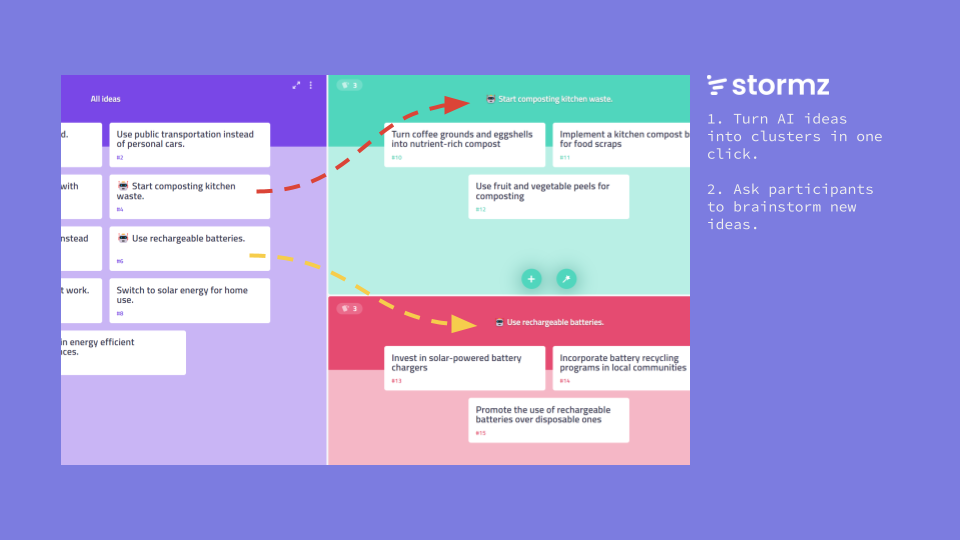
If you are using Miro or Mural, you can add a bot emoji or a dedicated label and reserve a certain color of notes for AI ideas.
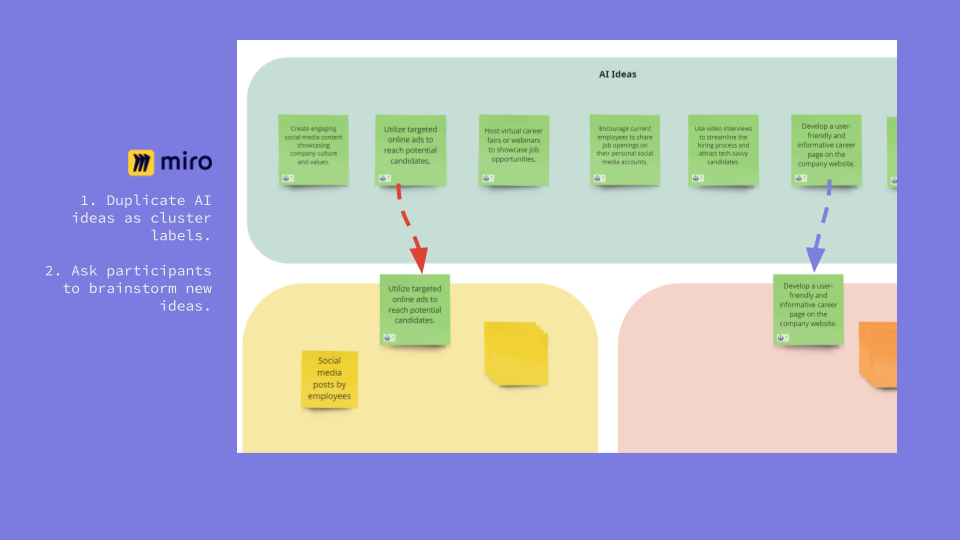
2. Use AI to improve human ideation, not distract from it
Always start by asking participants to generate their own ideas. Then, and only then, should you bring in AI to generate a second set of ideas. Provide the AI with access to the participants’ ideas for context, so that the ideas generated are different from the first ones but are also relevant. The AI is going to learn from the first ideas of the participants.
Conversely, you should never end with the AI ideas but always end with your human input. Ask the participants to build both on their ideas—the first layer—but also on the AI-generated ones—the second layer. This can push them to think of new possibilities and insights.
3. Ration AI-generated ideas and don’t flood participants with too many.
Here is a major pitfall to watch out for! It’s super easy to generate tons of ideas in seconds with an AI. Don’t do that: it’s going to overwhelm and scare your participants. Instead, create an AI backlog in your whiteboard: it’s a reserved area for AI, and as a facilitator, I only drop one or two or three ideas at a time in the main collaborative space so that the participants can digest them and “springboard” on them. In Stormz, by the way, this feature is built in automatically.
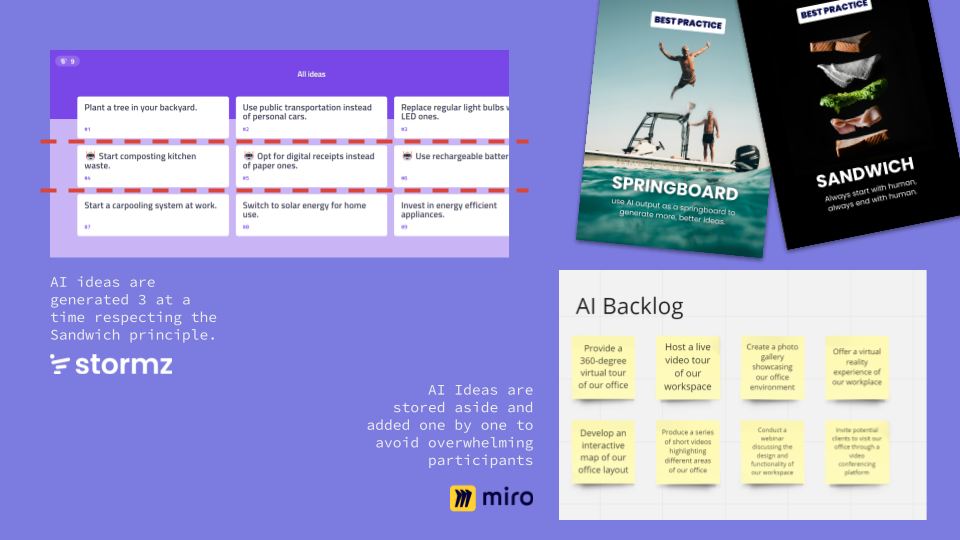
With these three tips, you are well equipped to use AI, during your sessions, when brainstorming. But there are other, better ways to leverage AI to improve the ideation phase of a workshop. Let’s go to the next use case: using AI to critique ideas.
Use Case No. 6 – Getting AI to roast participants’ ideas
Let’s explore another use case for AI during live sessions: roasting participants’ ideas.
Having ideas critiqued by colleagues, managers, employees or even strangers, can be a sensitive matter. If criticism comes from an AI chatbot, in my experience, nobody’s feelings are hurt.
Before your session, you can prepare a prompt that asks AI to critique ideas based on a clear structure, such as:
- What is good about this idea?
- What could be the issue with this idea and why?
- Step it up: what could be improved?
You can use this type of assessment-by-AI in many different ways during workshops. For example, you might want to ask participants to access their own AI tools and suggest effective prompts they can pick among to privately work on improving their ideas, or to do it in pairs in breakout spaces.
Once they have received their AI-powered critique, they should step back, re-read everything, reflect, and edit their idea, turning it into a stronger concept. Repeat this a couple of times, perhaps with slight variations to the prompt, and you can quickly go from a seed of an idea to a robust concept.
Getting help from GenAI to document the outcome of sessions
The last part of the workshop process where GenAI can lend a hand is, of course, session documentation and reporting. While reporting itself might fall more into the category of using AI for generic written content, and is not specific to facilitation or training, there are a few use cases quite specific to our topic.
The one I’ll present here is, once more, a solution to a typical pain point in training and development: quickly summarizing large amounts of information. How can AI help with that?
Use Case No. 7 – Summarizing information and contributions
When facilitating a workshop, it can be very rewarding to surprise participants, exceeding their expectations with tasks that feel unlikely, even impossible. Let’s say a group is taking a break, for example, leaving behind a whiteboard full of messy notes, and returns to find a neat output document organized and ready for discussion. Feels like magic!
AI definitively has the capabilities to analyze and summarize vast amounts of written text on the spot, obtaining results that, while imperfect, could simply not happen without the help of this technology. You can export long lists of answers and virtual sticky notes into a document, then run them all through a prompt. You might, for example, ask the AI to categorize and summarize idea groups, keywords, and emotions evoked.
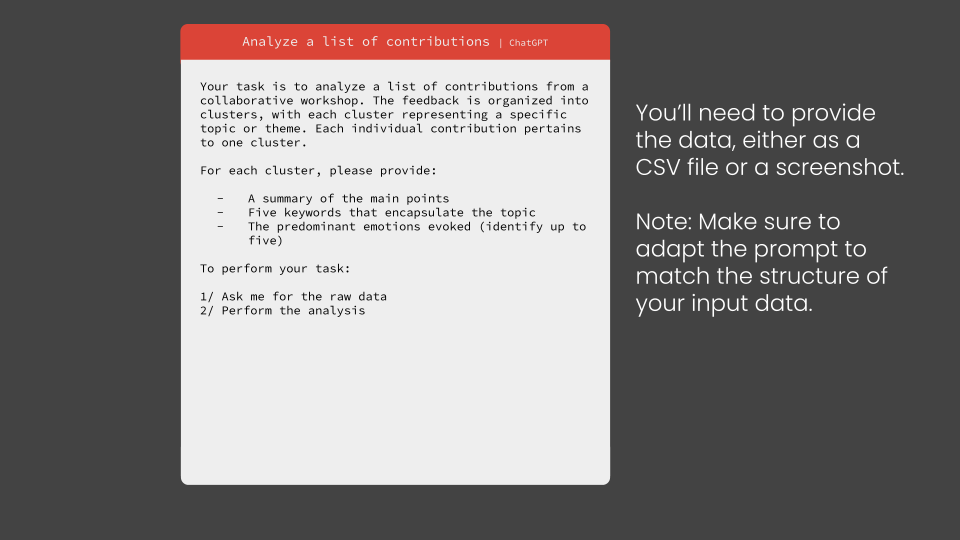
One very important thing to remember here is that AI cannot be fully trusted with this sort of task, because of the “hallucinations” it can produce. You never can trust an AI 100%. It can be biased, and it can include hallucinated details, for example by making up some contributions. This does not mean you cannot use it as a springboard!
In fact, you can use imperfect summaries as a way to enhance follow-up conversations. Turn this into a learning experience. Display the AI-generated summary–enjoy the wow factor–then ask questions to the audience: Does this summary capture your main points? Do you agree? Do you disagree? Is there any key element that is missing? Should we adjust or remove anything?
So think of it this way: the AI isn’t replacing the discussion. It is handling all the initial heavy lifting, thereby creating more time for meaningful dialogue and freeing your attention to focus on human interactions.
A note on privacy concerns
I hope these use cases have inspired you to go try something new. But before ending the article, let us give some consideration to the important challenges related to privacy concerns. Here are three quick tips on how to handle privacy concerns when using AI for facilitation and training.
Check privacy settings
Looking at Open AI’s ChatGPT, for example, make sure you have privacy settings on. In Data Controls, “Improve the model for everyone”, which means you are authorizing OpenAI to train the model on what you are doing, should be switched off, especially when you are using the model to analyze and summarize client data.
Consult with your clients
You really don’t want to be feeding your client’s data to AI if they have a clear policy against it! Always tell clients what tools you intend to use, and discuss which technology is acceptable or unacceptable to them. In the future, I think we will see more and more companies having their own, proprietary AI you might be able to leverage.
Use a local open-source Large Language Model
More and more local, open-source options are becoming available. They are now (in early 2025) good enough for a lot of tasks, including repurposing content or translating (but be even more on the look out for hallucination issues).
In closing
How are you feeling about experimenting with AI systems in your next training course or workshop? Have you already identified micro use-cases that can speed up and, even better, improve your workflow?
Here are a few things you might want to try out if I have managed to awaken your curiosity about how these tools can interact with group processes and learning:
Try out Stormz. Stormz is a brainstorming and decision-making platform designed with facilitation in mind, now augmented with AI tools.
Have you already tested SessionLab’s AI tool? It can speed up ideation and, as we saw in the use-case above, help you go quickly from a high-level plan to a fully designed session flow.
To keep tinkering and learning together, sign up for my newsletter, where I share musings, ideas and resources on AI skills and more. You can also join us at the AI Tinkerers’ Club. Practicing AI skills is a learning journey for all of us and it can be very helpful to explore that knowledge together.
Read about other, not AI-based, tech tools that can improve your work as a facilitator in this article.

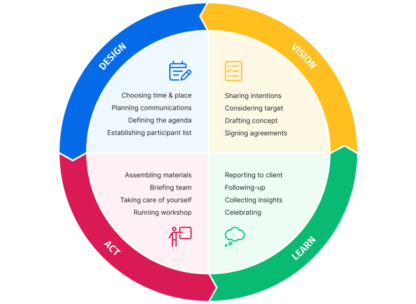
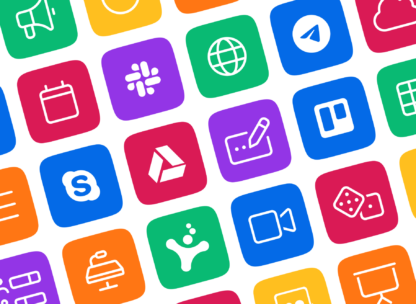
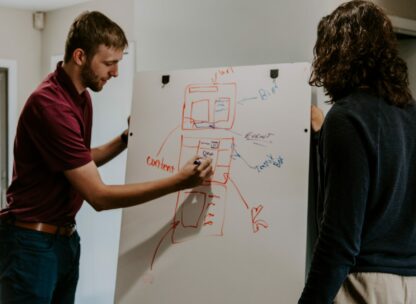
I’ve been deepening my work with AI – my new business partner) and your use cases sparked some new ideas. Thanks!